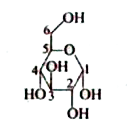Following enthalpy changes are given:
α−Dglucose(s)→α−Dglucoes(aq),ΔH=10.72kJ
β−Dglucose(s)→β−Dglucose(aq),ΔH=4.68kJ
α−Dglucose(aq)→β−Dglucose(aq),ΔH=1.16kJ
Calculate enthalpy change in
α−Dglucose(s)→β−Dglucose(s)
14.24kJ
16.56kJ
7.2kJ
4.88kJ
To calculate the enthalpy change for the reaction:
α-D glucose (s)→β-D glucose (s)
we can use Hess's Law, which states that the total enthalpy change for a reaction is the sum of the enthalpy changes for the individual steps of the reaction.
Given Enthalpy Changes:
1. α-D glucose (s)→α-D glucose (aq),ΔH1=10.72kJ
2. β-D glucose (s)→β-D glucose (aq),ΔH2=4.68kJ
3. α-D glucose (aq)→β-D glucose (aq),ΔH3=1.16kJ
1. Write the target reaction:
We want to find the enthalpy change for:
α-D glucose (s)→β-D glucose (s)
2. Express the target reaction using the given reactions:
We can achieve the target reaction by combining the three given reactions. The steps are:
- Convert α-D glucose (s) to α-D glucose (aq) using the first reaction.
- Convert α-D glucose (aq) to β-D glucose (aq) using the third reaction.
- Convert β-D glucose (aq) to β-D glucose (s) using the second reaction (but in reverse).
3. Write the equations:
- From reaction 1:
α-D glucose (s)→α-D glucose (aq),ΔH1=+10.72kJ
- From reaction 3:
α-D glucose (aq)→β-D glucose (aq),ΔH3=+1.16kJ
- From reaction 2 (reverse):
β-D glucose (aq)→β-D glucose (s),ΔH2=−4.68kJ
4. Combine the enthalpy changes:
Using Hess's Law:
ΔH=ΔH1+ΔH3+(−ΔH2)
Substituting the values:
ΔH=10.72kJ+1.16kJ−4.68kJ
5. Calculate the total enthalpy change:
ΔH=10.72+1.16−4.68=7.20kJ
Final Answer:
The enthalpy change for the reaction α-D glucose (s)→β-D glucose (s) is:
ΔH=7.20kJ
1. α-D glucose (s)→α-D glucose (aq),ΔH1=10.72kJ
2. β-D glucose (s)→β-D glucose (aq),ΔH2=4.68kJ
3. α-D glucose (aq)→β-D glucose (aq),ΔH3=1.16kJ
We want to find the enthalpy change for:
α-D glucose (s)→β-D glucose (s)
We can achieve the target reaction by combining the three given reactions. The steps are:
- Convert α-D glucose (s) to α-D glucose (aq) using the first reaction.
- Convert α-D glucose (aq) to β-D glucose (aq) using the third reaction.
- Convert β-D glucose (aq) to β-D glucose (s) using the second reaction (but in reverse).
- From reaction 1:
α-D glucose (s)→α-D glucose (aq),ΔH1=+10.72kJ
- From reaction 3:
α-D glucose (aq)→β-D glucose (aq),ΔH3=+1.16kJ
- From reaction 2 (reverse):
β-D glucose (aq)→β-D glucose (s),ΔH2=−4.68kJ
Using Hess's Law:
ΔH=ΔH1+ΔH3+(−ΔH2)
Substituting the values:
ΔH=10.72kJ+1.16kJ−4.68kJ
ΔH=10.72+1.16−4.68=7.20kJ
The enthalpy change for the reaction α-D glucose (s)→β-D glucose (s) is:
ΔH=7.20kJ
Topper's Solved these Questions
- THERMODYNAMICSBOOK - CENGAGE CHEMISTRY ENGLISHCHAPTER - THERMODYNAMICSEXERCISE - Multiple correct Answer Type
2 Videos
- THERMODYNAMICSBOOK - CENGAGE CHEMISTRY ENGLISHCHAPTER - THERMODYNAMICSEXERCISE - Exercises (Single Correct)
62 Videos
- THERMODYNAMICSBOOK - CENGAGE CHEMISTRY ENGLISHCHAPTER - THERMODYNAMICSEXERCISE - Exercises (Linked Comprehension)
74 Videos
- STOICHIOMETRYBOOK - CENGAGE CHEMISTRY ENGLISHCHAPTER - STOICHIOMETRYEXERCISE - Archives Subjective
33 Videos
Similar Questions
Knowledge Check
α-D(+)-glucose and β-D(+) glucose are
AanomersBenantiomersCgeometrical isomersDepimersIn α-D-Glucose, the anomeric carbon is at :
 A1B2C4D5
A1B2C4D5
The enthalpy changes of some process are given below
α−Dglucose(s)+H2O→α−D−glucose(aq) Heat of dissolution =10.84kJ
β−Dglucose(s)+H2O→β−D−glucose(aq) Heat of dissolution = 4.68kJ
α−Dglucose(aq)→β−D−glucose(aq) Heat of mutarotation =−1.16kJ
The ΔH0for α−Dglucose(s)→β−Dglucose(s) is
View SolutionCorrect statement for α-D-glucose is
View Solutionα−(D) glucose ⇔β−(D) glucose, equilibrium constant for this s 1.8. The percentage of α−(D) glucose at equilibrium is
View Solutionα−D−glucose and β−D−glucose are enantiomers. True/False
View SolutionThe number of chiral carbons in β−D(+)−glucose is:
View SolutionWhat would be the correct structure of β−D−Glucose?
View Solution
